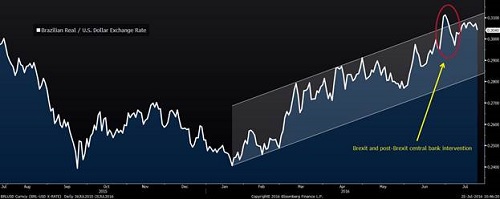Brazil: The Rise From The Bottom Continues
Tim Shirata | Jul 29, 2016 01:42AM ET
We began to get bullish on Brazil in March (you can read the Bloomberg coverage of our analysis here ). Since that time, Brazilian market and economic conditions have continued to move ahead, supporting a shift in business and consumer confidence, and shifting the psychology of global investors. The 2016 Summer Olympics open in Rio on August 5; barring mishaps, the games should also bolster the sense that Brazil has put the worst behind it.
One of the star performers of Brazil’s recovery from the economy’s lows has been the state oil company, Petróleo Brasileiro S.A. (NYSE:PBR), better known as Petrobras. The company was at the epicenter of the bribery and corruption scandal that has taken down dozens of senior figures in Brazilian business and politics (including the current president, Dilma Rousseff, against whom impeachment proceedings are ongoing).
Brazilian Energy Expertise Is Prodigious
Underneath the scandals, and in spite of the corruption, the Brazilian energy sector, including PBR, has a remarkable technical track record, particularly in the development of the off-shore reserves known as “pre-salt.” The pre-salt reserves exist on both sides of the Atlantic, off the shores of Brazil and Angola. They originated when Africa and South America split apart more than a hundred million years ago, the result of organic matter laid down in vast lakes that were inundated by the sea and buried by later volcanic activity.
These large reserves are among the most technically difficult offshore reserves to recover. The total depth of pre-salt wells can include miles of water, sedimentary and volcanic rock, and compressed ancient salt. The technical complexities of identifying, mapping, and drilling -- not to mention the sheer logistics of carrying out such a project hundreds of miles offshore -- were daunting. But the pre-salt wells are now flowing, with completion costs down to $80 million from an initial $240 million.
Pre-salt production was 41,000 barrels per day in 2010 and in May 2016 it exceeded 1 million barrels per day. Meanwhile, two of the three large geological formations remain largely unexplored. Pre-salt production is the culmination of nearly a half century of offshore experience. In spite of Brazil’s political and economic woes, the Brazilian energy sector has been no slouch in terms of technical innovation and expertise. It can continue to benefit as the global energy sector rebounds from its deep cyclical downturn, and as Brazil continues to move forward from its recent political chaos.
The confluence of the global commodity downturn and the climax of Brazil’s political storm took the Brazil's currency, the real, to lows last seen in 2002. From the bottom in January, the real has seen significant appreciation. In late June, Brexit jitters caused it to spike, and action by Brazil’s central bank damped it down again. It remains in an upward channel, driven by global desire for the high yield of Brazilian debt.
We are bullish on Brazilian debt, because we believe that interest rates can fall, and the real can continue to appreciate. However, the real is close to the top of its channel, and a 5-to-10% correction is possible. The Brazilian government knows that the real’s collapse has done indispensable work in helping boost exports and curtail imports, and the central bank may take action from time to time to control the currency’s continued appreciation.
In sum, Brazil is doing better, and in the medium term, we continue to be bullish on Brazilian bonds and the Brazilian currency, while we look for a near-term correction.

Investment implications: We’re bullish on Brazil. We favor Brazilian bonds and currency, although we believe that there may be a near-term correction in the real as the Brazilian government moderates its ascent. When such a correction has occurred, we may also become bullish on Brazilian stocks.

Trading in financial instruments and/or cryptocurrencies involves high risks including the risk of losing some, or all, of your investment amount, and may not be suitable for all investors. Prices of cryptocurrencies are extremely volatile and may be affected by external factors such as financial, regulatory or political events. Trading on margin increases the financial risks.
Before deciding to trade in financial instrument or cryptocurrencies you should be fully informed of the risks and costs associated with trading the financial markets, carefully consider your investment objectives, level of experience, and risk appetite, and seek professional advice where needed.
Fusion Media would like to remind you that the data contained in this website is not necessarily real-time nor accurate. The data and prices on the website are not necessarily provided by any market or exchange, but may be provided by market makers, and so prices may not be accurate and may differ from the actual price at any given market, meaning prices are indicative and not appropriate for trading purposes. Fusion Media and any provider of the data contained in this website will not accept liability for any loss or damage as a result of your trading, or your reliance on the information contained within this website.
It is prohibited to use, store, reproduce, display, modify, transmit or distribute the data contained in this website without the explicit prior written permission of Fusion Media and/or the data provider. All intellectual property rights are reserved by the providers and/or the exchange providing the data contained in this website.
Fusion Media may be compensated by the advertisers that appear on the website, based on your interaction with the advertisements or advertisers.